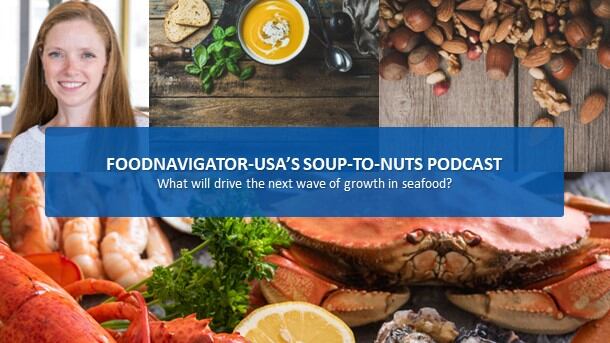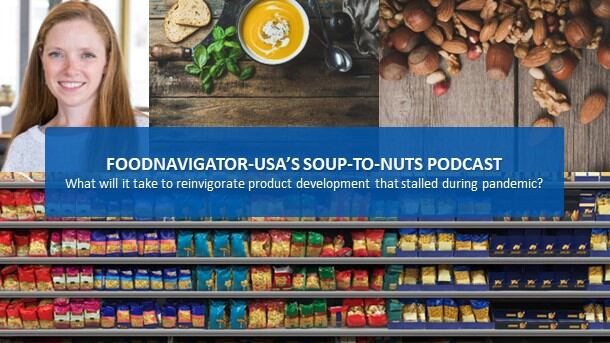But as supply chains continue to recover and inflation starts to slow, the tide once again is changing for seafood segment in 2023, and retailers and brands could see a new wave of growth, according to consumer and market research from Circana, which was previously IRI.
In this episode of FoodNavigator-USA’s Soup-To-Nuts podcast, Circana’s executive vice president and Americas protein practice leader Chris Dubois shares how the competitive landscape for retail seafood is evolving, including what types of seafood consumers want, who is shopping the seafood case and how to engage them both in store and online.
[Editor’s note: Never miss an episode of FoodNavigator-USA’s Soup-To-Nuts Podcast – subscribe today.]
The current landscape
After a sharp spike at the start of the pandemic and ongoing heightened demand kept year-over-year finfish and shellfish sales up in the high double-digits through 2020, Circana data crunched by 210 Analytics shows both fell sharply early in 2021 as inflation began driving up prices and squeezing consumer budgets. By 2022, the amount of finfish and shellfish purchased in the US was down in the mid-teens to nearly 30% year-over-year.
But as inflation begins to ease, the lows of mid-2022 are slowly ebbing and sales and volume are beginning to rise again and this time DeBois says they could have staying-power as consumer perceptions of seafood have shifted from pre-pandemic.
He explains during the pandemic as many consumers learned how to cook seafood they found they wanted to buy it again – not just because it was one of the few proteins available during early lockdowns, but because they liked it.
“We saw repurchase rates very strong [in early 2020]. And what was driving the sales for the first, call it 18 to 24 months [of the pandemic] was really consumers learning how to cook,” wanting to recreate restaurant meals at home and still having money in their pockets, he said.
This newfound skill and desire for seafood stayed with consumers even as inflation pushed it out of many shoppers’ reach financially, but DuBois said he believes that as prices come back down, as they have in recent months, consumers will eagerly return to the space and volume will rise along side sales.
“For people who would say seafood was a flash in the pan in 2020, 2021 or early 2022, it is not the case. We’re seeing thing stabilize and I think the beginnings of the foundation here for growth going forward,” he said.
Diversifying the seafood cases will diversify the consumer base
During the pandemic and the economic downturn that followed many retailers and brands rationalized SKUs across categories – choosing to focus on top sellers that they knew they could keep in stock and easily turn. But as the economy stabilizes, DuBois recommends diversifying the seafood case to include more species and premium call-outs that excite consumers will further drive sales.
“One of the big themes that’s emerged over the last three to four years was just salmon became an incredible powerhouse in the seafood case” with consumers continuing to buy it at higher volumes despite higher prices, DuBois said.
But, he added, “the hard part is when you have a seafood case that’s dominated by one species, that becomes very one dimensional and people want a lot more variety. So, if seafood stabilizes here, I think the big play in 2023 is that retailers are going to be looking to add back species that drive some extra volume and excitement in the case.”
In particular, he predicts shellfish, which “took it on the chin back in ’22,” wil come back and draw in new consumers.
He also sees a case for stocking more wild caught seafood, which resonates well with consumers who are interested in nature and ‘natural.’ He compared the opportunity here to that of grass fed and organic claims in the beef category.
“It’s, honestly, very similar, pulling in a lot of the same consumers,” he said.
Convenient formats, new recipes appeal to younger consumers
As prices come down and consumer comfort preparing seafood goes up thanks to in part to the lessons they learned during the pandemic as well as retailers and brands offering more convenient formats and recipes, DuBois predicts seafood shoppers will diversify beyond the older, more affluent base that has dominated for years.
He explained that while the seafood case currently skews heavily towards upper-income consumers and older consumers who are more advanced in their careers with higher salaries and savings, the introduction of the air fryer opened the door for frozen seafood to appeal to younger consumers and even families by making it an easy snack or mid-week meal.
He also noted that younger Millennials and Gen Z consumers are coming into their spending power and looking for healthier and more sustainable options – for which seafood is well positioned to appeal.
Digital marketing can help drive longer-term sales
To further appeal to younger and more diverse consumers, DuBois recommends retailers and brands lean into digital marketing to better tell the segment’s sustainability story and provide an enhanced level of transparency and traceability.
“There is a big in-store opportunity that cuts across not only just younger generations but older ones as well” to show consumers how seafood is sourced and how to prepare it through videos and digital engagement, DuBois explained.
He noted that many players in the seafood segment already have the technology and traceability practices in place to show consumers exactly (or at least pretty close) where seafood was caught and its impact on the environment. Sharing this with shoppers is a huge way to build trust, engagement and drive trial, he added.
DuBois also argued that marketers should lean into digital and social media to inspire and reinforce cooking skills consumers gained during the pandemic to help increase the frequency and diversity of seafood-based meals they prepare at home.
“Having YouTube videos or TikToks that go viral change what people buy, almost overnight. It really rocks supply chains. So by making [recipes] a little bit more visual and easier to prepare, it totally engages – especially the younger generation, and gives them the confidence” to buy and make seafood at home, he said.
“So, to me as a marketer, I would be thinking very hard about how do I increase the confidence of consumers to be able to consume the product – and more and more that is really through social media and video,” he added.
DuBois also recommends retailers and marketers lean on the strong health halo that seafood has as more consumers make the connection between diet and their health and seek products that will better support their physical well-being.
Ultimately, through this combination of diversifying product assortment and engaging more deeply with consumers digitally around sustainability, recipe development and health, DuBois predicts that 2023 will be a strong year for retail seafood in which the category not only stabilizes but returns to growth.




